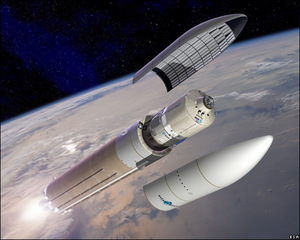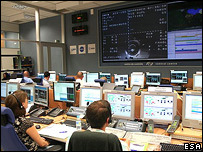
|
| ©ESA |
The cargo truck will test its systems with two close approaches and retreats before finally linking up with the orbiting platform next Thursday.
The ship, which is carrying just under five tonnes of supplies for the station's astronauts, flies under the control of autonomous computers.
The vehicle's performance so far has been exemplary, say space officials.
"We've had the usual small anomalies; we're learning how to fly the bird - but nothing that has been really difficult," said John Ellwood from the European Space Agency (Esa).
Button pressing
Launched earlier this month, Jules Verne, also known as the Automated Transfer Vehicle (ATV), was parked up in front of the International Space Station (ISS) during the recent shuttle visit.
But now that the Endeavour orbiter and its crew are on the ground, controllers have commanded the truck to come back over the platform for two demonstration days.
Jules Verne is designed to make its own way to the platform and complete an automated attachment. Humans will only interfere if something is seen to be going wrong.
But as a new ship, the ATV must prove itself; and the demos will allow for the checkout of all the vehicle's close-manoeuvring systems, including its advanced GPS technology and optical sensors.
The first practice session, on Saturday, will see the ATV move to a hold point just 3,500m (2 miles) behind and 100m (330ft) above the station.
The second, on Monday, will see Jules Verne edge to just 12m (40ft) from the back of the ISS; and, hopefully, aligned straight with the docking mechanism.
The second day will also give the station crew an opportunity to practise their safety interventions.
By pressing buttons on a special panel positioned in the ISS's Zvezda module, it is possible for the astronauts to command the ATV to stop in its tracks and even move away from the station.
Once these operations have been completed, ground controllers will assess the results, before giving the green light to Jules Verne to try a docking for real.
At the moment, this procedure is booked to begin next Thursday at 1144 GMT, with the ATV starting from a hold point 250m (820ft) from the ISS.
Contact with Zvezda's docking mechanism is timed for 1441 GMT.
The cargo ship's speed relative to the station at that moment will be about seven cm/second (three inches/s). In reality, of course, the two objects - cargo ship and station - will be moving across the surface of the Earth at about 27,000km/h (17,000mph).
Once a seal and electrical connections have been confirmed, and the astronauts have checked the air inside the ATV is safe to breathe - the supplies can be unloaded.
Crews will use Jules Verne like a store cupboard.
They will go into the pressurised vessel to obtain food, clothing and equipment when they need it. Fuel will be piped across to the main station complex; water will be carried out in bags; air will simply be vented from taps.
As the supplies are depleted, the space will be filled with rubbish. The ATV is expected to take this waste into a controlled burn-up over the Pacific Ocean when it leaves the station later this year.
Cool running
Esa is understandably delighted with the way the mission has gone so far. There was a glitch associated with the propulsion system shortly after launch but back-up systems kicked in as designed; and the issue that triggered the alert was resolved within a day or so.

|
| ©ESA |
| There is a dedicated control room for the ATV in Toulouse |
ATV controllers in Toulouse, France, have seen their screens light up with alarms on a number of occasions when sensors on the spacecraft have detected low temperatures.
But engineers say this resulted from warning values being set too strictly prior to flight and did not indicate there was anything seriously wrong with the truck.
The trigger values had subsequently been re-set, said Dr Ellwood. "This bird has got so many thermisters, so many sensors, if we didn't have some things set wrongly it would have been a surprise," he told BBC News.
"It's been virtually perfect so far, but obviously over next few days we'll all be a little bit nervous, naturally."
Esa's ATV project manger added: "We've got a lot of things to do, and it would be nice to dock by next Thursday; but if there's anything we've got question marks about, we'll hang on. We don't have to rush this."
ATV flights over the coming years will be the way Europe pays its way on the space station project.



Reader Comments
to our Newsletter